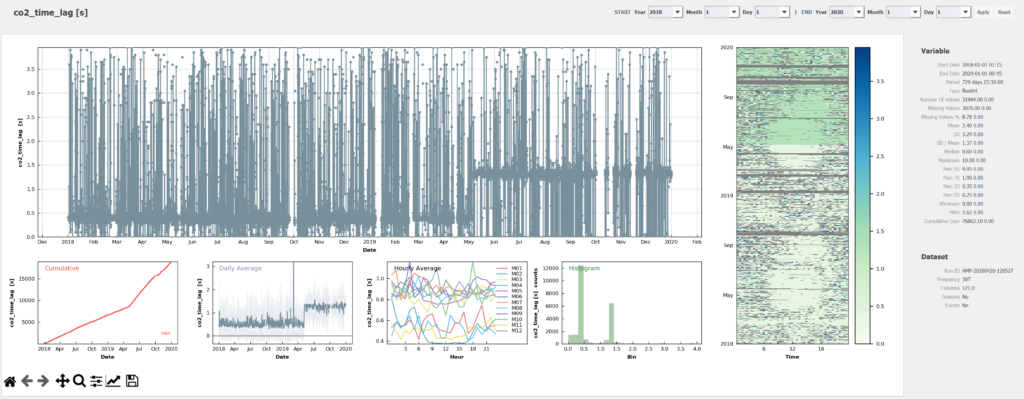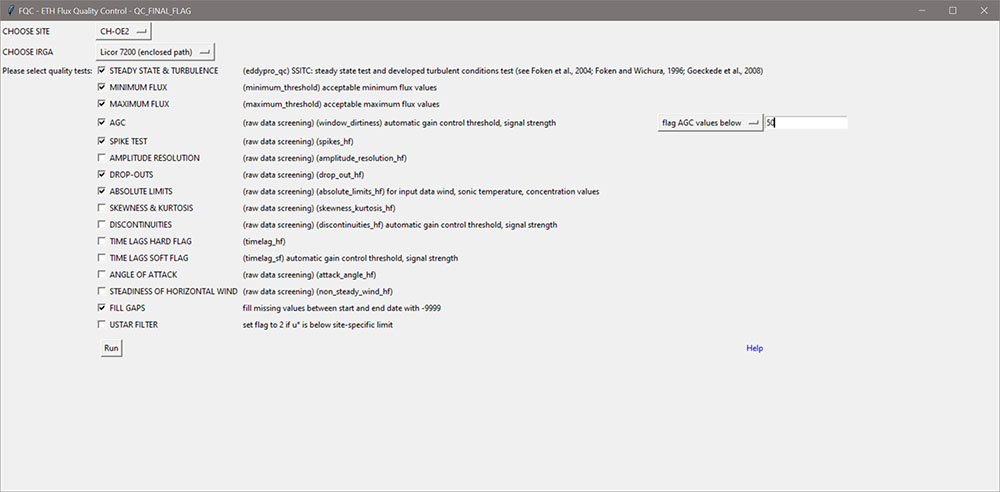CH-OE2 / FF-202004
Flux calculations for years 2018 (updated), 2019 (new) and 2020 so far (new).
- Fluxes 2018 were re-calculated because of the Wrong Calibration Gas 2017.
- Fluxes 2020 include data so far, until incl. March 2020.
Contents
Level-1 Fluxes
- Python script for conversion to CSV and flux calculations: FCT v0.94
- With this FCT version, the calibration gas issue can be corrected during the conversion of the EC raw data files from binary to CSV, before they are used in flux calculations.
- EddyPro version: 7.0.6 (18 Dec 2019)
- For an overview of raw data formats see here.
Calibration Gas Issue
See here for more details on this issue.
The calibration gas used to calibrate IRGA CO2 measurements during the time periods 2018_2, 2019_1 and 2019_2 was wrong and the CO2 measurements needed to be corrected before flux calculations. This correction cannot be done in EddyPro directly. High-res CO2 raw data of these time periods were multiplied by a factor of 0.974 during the conversion from the raw binary format to the CSV format.
(I first corrected for this issue using the same approach as described here for CH-AWS and using a separate Python script, but then I found an easier solution by directly applying the gain during the conversion to CSV.)
Workflow
- All raw binary files were first converted to CSV format.
- 2018_1 and 2019_3 were not affected by the calibration gas issue and were directly converted into CSV, using the appropriate FRMT file.
- 2018_2, 2019_1 and 2019_2 were affected by the calibration gas issue and needed correction. The gain of 0.974 was applied to the two CO2 columns (CO2 in ppm and mmol) during their conversion from binary to CSV. This means that the CSV file format of these corrected files is the same (i.e. same columns and same order of columns) as for the other time periods.
- Fluxes were then calculated for the complete year from the CSV files. Since all CSV files had the same columns,
- CSV files for 2018_1 and 2018_2 were pooled to calculate fluxes for the complete year 2018, and
- CSV files for 2019_1, 2019_2 and 2019_3 were pooled to calculate fluxes for 2019.
Open Lag Runs
The lag time between SA and IRGA was checked for 2018 and 2019 in relatively large time windows. This was done by searching the max covariance without using a default lag time in EddyPro, i.e. all found lag times in the EddyPro full_output file show found lag times. The peak of the distribution of all found lag times per year were:
- 2018: peak @0.35s for CO2, @0.45s for H2O, final lag search window 0-5s
Due to these findings, the lag search window in 2018 was 0-5s, with default lag times of 0.35s (CO2) and 0.45s (H2O) in EddyPro. - 2019: Special case: there is jump in lag times on 6 May 2019 13:30, nothing documented on GIN
- 2019_1: peak @0.35s for CO2, @0.45 for H2O
- 2019_2 and 2019_3: peak @1.30s for CO2, @1.40s for H2O
- 2020: peak @1.30s for CO2 (search in 0-5s), no default lag for H2O (search in 0-15s since the found lag times were sometimes close to 10s in a 0-10s search window)
- As a consequence, in 2019 no default lag time was defined, because it would have been necessary to fragment the data (i.e. separate flux runs for first and second part of the year would have been necessary). It is desirable to calculate the complete year in one single run.
I think it is more important to calculate all parts in one run than splitting the parts up “only” because of a different default lag time. The lag window can be defined quite narrowly (see plots), so I would not expect any problems when not defining the default lag time in 2019. The lag search window in 2019 was the same as in 2018: 0-5s.

CH-OE2: found lag times for CO2 in 2018 and 2019. Note the lag time jump to higher lag times on 6 May 2019.
Spectral Correction
The spectral correction worked without any errors in both years 2018 and 2019. I did a first test by calculating fluxes for each time period separately and using the EddyPro spectral assessment file from longer time periods for the spectral correction of shorter time periods, but results seemed to indicate an error during the correction (high spectral correction factors for H2O). After pooling all 2018 and 2019 data, respectively, the correction seemed to work without errors.
For the correction of the so far available fluxes 2020 the spectral assessment file from the 2019 run was used (without errors, worked).
Off-season Carbon Uptake Correction (Burba Correction)
Not necessary since the LI-7200 was used.
Level-2 Fluxes
- Quality control with Python script FQC v2.1.0.
- QC settings are shown here:

Last Updated on 18 Feb 2024 22:11
